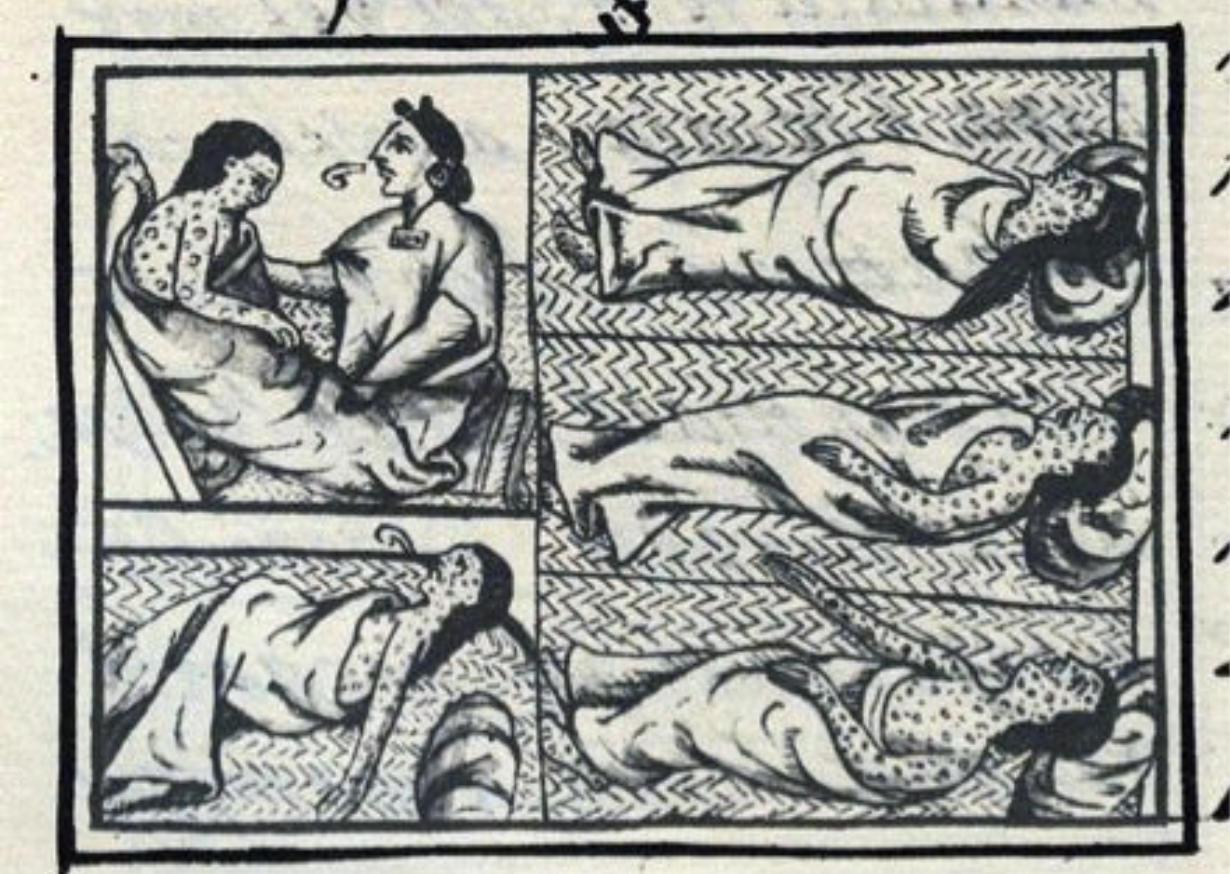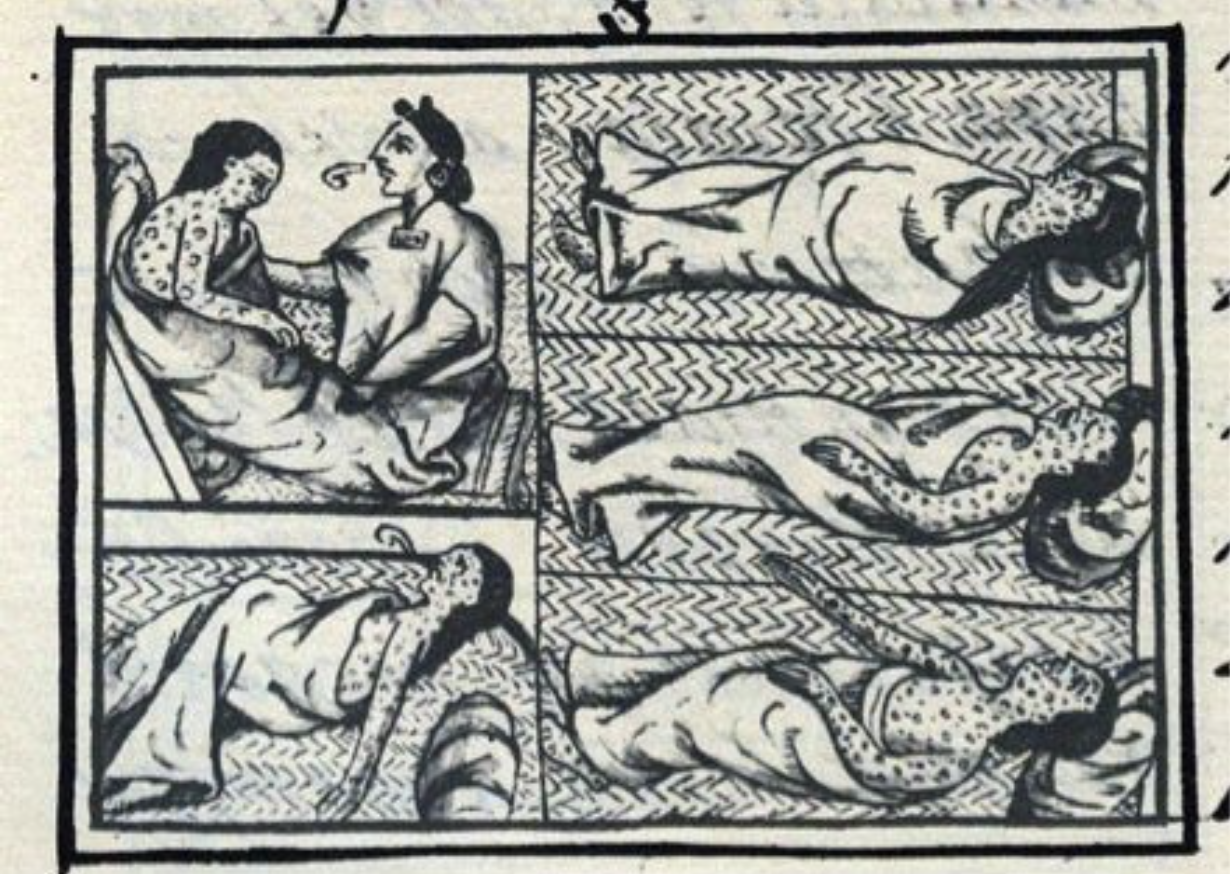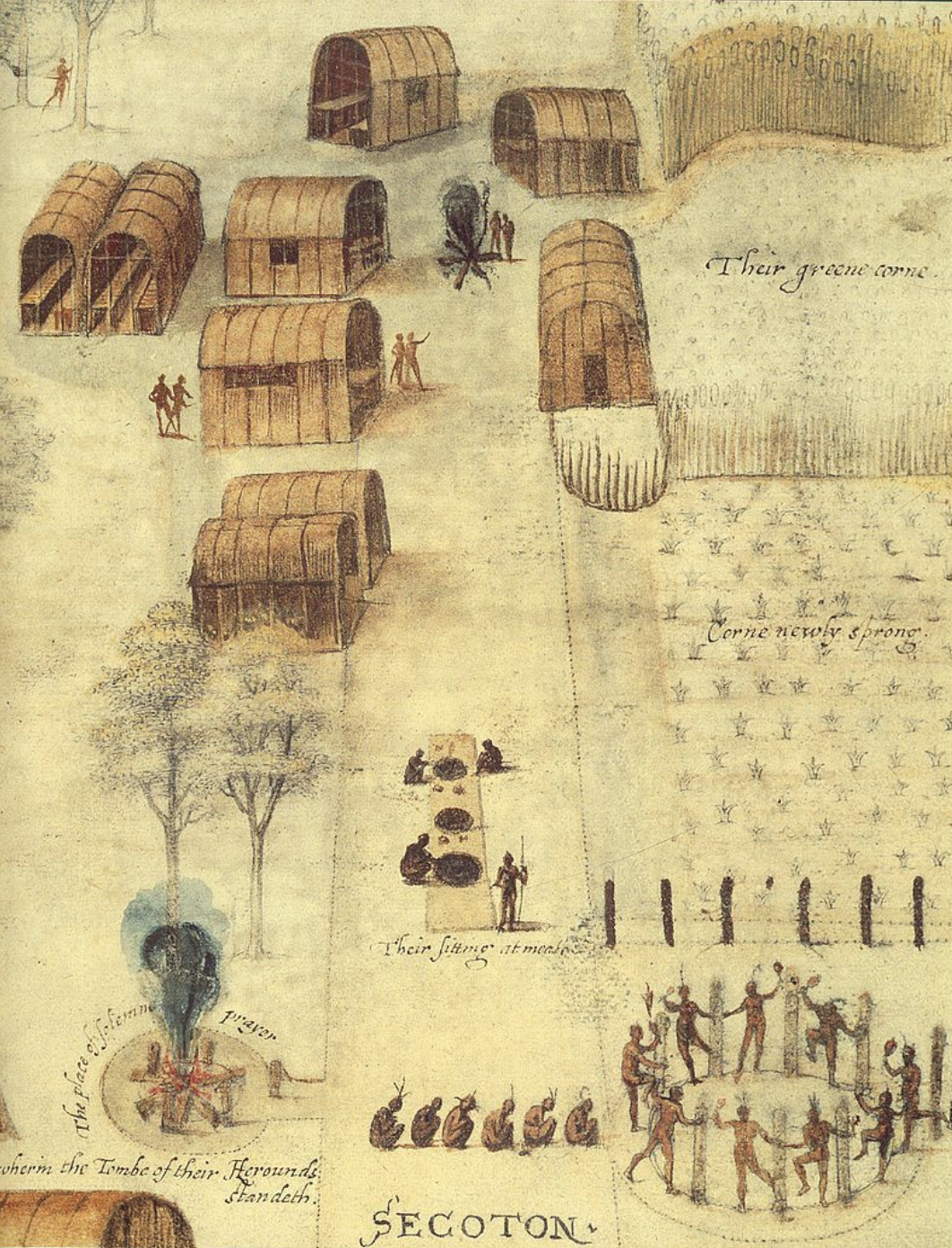APUSH Summer 1
1/65
Earn XP
Description and Tags
1491-1607
Name | Mastery | Learn | Test | Matching | Spaced |
|---|
No study sessions yet.
66 Terms

The image most directly reflects
A. elements of Native American religious rituals to heal the sick.
B. social institutions devoted to the treatment of the ill.
C. the expansive experience of poverty among Native Americans.
D. the impact of deadly epidemics on Native Americans.
D. the impact of deadly epidemics on Native Americans.
Clash of Empires
"KING FRANCIS the first having heard the report of Captaine Cartier his Pilot generall in his two former Voyages of discovery, as well by writing as by word of mouth, touching that which hee had found and seene in the Westerne partes discovered by him in the parts of Canada and Hochelaga, and having also seene and talked with the people, which the sayd Cartier had brought out of those Countreys, whereof one was king of Canada, whose name was Donnacona, and others: which after that they had bene a long time in France and Britaine,' were baptized at their owne desire and request, and died in the sayd countrey of Britaine."
The use of the term Hochelaga indicates that the French
A. deferred to Indigenous expertise.
B. were extremely ignorant.
C. stole indigenous ideas.
D. wanted to impress their French, Spanish, and Dutch competitors.
A. deferred to Indigenous expertise.

Conditions like those shown in the image contributed most significantly to what broader historical development?
A. The mass death of Native American and Spanish populations in the New World.
B. The advantage of the Spanish and Portuguese in conquering Native American populations.
C. The strengthening of Native American alliances through the Caribbean.
D. The rapid development of immunity to future epidemics.
B. The advantage of the Spanish and Portuguese in conquering Native American populations.

Which of the following regions of North America developed MOST similarly to the Aztecs?
A. The Great Plains
B. The Mississippi Valley
C. The Pacific Coast
D. The Great Lakes
B. The Mississippi Valley
The Voyages of Jacques Cartier, 1535
As we drew near to their [the Native Americans’] village, great numbers of the inhabitants came out to meet us and gave us a hearty welcome, according to the custom of the country. And we were led by our guides and those who were conducting us into the middle of the village, where there was an open square between the houses, about a stone’s throw or thereabouts in width each way. They signaled to us that we should come to a halt here, which we did. And at once all the girls and women of the village, some of whom had children in their arms, crowded about us, rubbing our faces, arms, and other parts of the upper portions of our bodies which they could touch, weeping for joy at the sight of us and giving us the best welcome they could.
Which of the following is true about French exploration in the New World?
A. The French developed the earliest and most extensive settlements in the New World.
B. The French were primarily motivated by the discovery of gold.
C. The French were the least successful Europeans in converting Native Americans to Christianity.
D. The French extracted a large amount of wealth from the fur trade.
D. The French extracted a large amount of wealth from the fur trade.
Bartoleme de Las Casas and Juan Gines de Sepulveda
"These people are the most guileless, the most devoid of wickedness and duplicity, the most obedient and faithful to their native masters and to the Spanish Christians whom they serve. They are by nature the most humble, patient, and peaceable, holding no grudges, free from embroilments, neither excitable nor quarrelsome. …They are… very apt to receive our holy Catholic faith, to be endowed with virtuous customs, and to behave in a godly fashion. Yet into this sheepfold, into this land of meek outcasts there came some Spaniards who immediately behaved like ravening wild beasts, wolves, tigers, or lions that had been starved for many days." de las Casas, Bartolome. An Account, Much Abbreviated, of the Destruction of the Indies with Related Texts. Ed. Franklin Knight. Trans. Andrew Hurley. N.p.: Hackett, 2003. Print. "The Spanish have a perfect right to rule these barbarians of the New World and the adjacent islands, who in prudence, skill, virtues, and humanity are as inferior to the Spanish as children to adults, or women to men; for there exists between the two as great a difference as between savage and cruel races and the most merciful, between the most intemperate [lacking in self-control] and the moderate and temperate, and, I might even say, between apes and men."
Which of the following groups would MOST LIKELY have supported the argument put forth by Sepulveda?
A. Native American leaders
B. Spanish missionaries
C. Spanish plantation owners in the New World
D. English and Dutch merchants
C. Spanish plantation owners in the New World
The Voyages of Jacques Cartier, 1535
As we drew near to their [the Native Americans’] village, great numbers of the inhabitants came out to meet us and gave us a hearty welcome, according to the custom of the country. And we were led by our guides and those who were conducting us into the middle of the village, where there was an open square between the houses, about a stone’s throw or thereabouts in width each way. They signaled to us that we should come to a halt here, which we did. And at once all the girls and women of the village, some of whom had children in their arms, crowded about us, rubbing our faces, arms, and other parts of the upper portions of our bodies which they could touch, weeping for joy at the sight of us and giving us the best welcome they could.
How does the passage above accurately contrast with Spanish explorers in the New World?
A. The Spanish encountered very few native peoples in their explorations.
B. The Spanish encountered mostly hunter-gatherer tribes who did not develop stable villages.
C. The Spanish quickly learned native languages, avoiding the need for signals and gestures.
D. The Spanish developed poorer relations with native peoples compared with the French.
D. The Spanish developed poorer relations with native peoples compared with the French.
Jordan Winthrop D, White over Black: American Attitudes toward the Negro
"From the first, Englishmen tended to set Negroes over against themselves, to stress what they conceived to be radically contrasting qualities of color, religion, and style of life… What Englishmen did not at first fully realize was that Negroes were potentially subjects for a special kind of obedience and subordination which was to arise as adventurous Englishmen sought to possess for themselves and their children one of the most bountiful dominions of the earth."
The historical account above illustrates what major historical trend among Europeans during the 16th and 17th centuries?
A. The primary role Christianity played in justifying the enslavement of Africans and Native peoples.
B. The belief in white superiority that became a rationalization for slavery.
C. The pattern of using the scientific method to support the treatment of Africans.
D. The significant challenges to notions of white supremacy.
B. The belief in white superiority that became a rationalization for slavery.
Richard Hakluyt, Divers Voyages Touching the Discovery of America and the Islands Adjacent, 1582
"I marvel not a little, right worshipful, that since the first discovery of America (which is now full four score and ten years), after so great conquests and plantings of the Spaniards and Portuguese there, that we of England could never have the grace to set fast footing in such fertile and temperate places as are left as yet unpossessed of them. But…I conceive great hope that the time approacheth and now is that we of England may share and part stakes (if we will ourselve) both with the Spaniard and the Portuguese in part of America and other regions yet undiscovered."
Based upon his perspective in the excerpt, Hakluyt would be MOST likely involved with which of the following future events?
A. The ending of the slave trade.
B. The settlement of Jamestown.
C. The Treaty of Tordesillas.
D. The French and Indian War.
B. The settlement of Jamestown.
“It is public opinion and knowledge that no end of deception is practiced and a thousand acts of robbery and violence are committed in the course of bartering and carrying off Negroes from their country and bringing them to the Indies and to Spain... They make war on one another, their gain being the capture of their own people, and they go after one another in the forests where they usually hunt... In this way, and contrary to all justice, a very great number of prisoners are taken. And no one is horrified that these people are ill-treating and selling one another, because they are considered uncivilized and savage... They put them aboard the ships under false pretenses, hoist anchor, set sail, and make off towards the high seas with their booty…”
The argument made in the excerpt most directly responds to which of the following developments?
A. Economic competition as a result of the Columbian Exchange in the New World
B. European expansion into both North and South America
C. Development of Spanish sugar plantations in the New World
D. Initial contact between Europeans and Africans during the Age of Discovery
C. Development of Spanish sugar plantations in the New World
New World Encounters
"I beg thee now to believe that, all miserable as we seem in thine eyes, we consider ourselves nevertheless much happier than thou in this, that we are very content with the little that we have; and believe also once for all, I pray, that thou deceivest thyself greatly if thou thinkest to persuade us that thy country is better than ours. For if France, as thou sayest, is a little terrestrial paradise, art thou sensible to leave it? And why abandon wives, children, relatives, and friends? Why risk thy life and thy property every year, and why venture thyself with such risk, in any season whatsoever, to the storms and tempests of the sea in order to come to a strange and barbarous country which thou considerest the poorest and least fortunate of the world? Besides, since we are wholly convinced of the contrary, we scarcely take the trouble to go to France, because we fear, with good reason, lest we find little satisfaction there, seeing, in our own experience, that those who are natives thereof leave it every year in order to enrich themselves on our shores."
Based on this account, Native Americans...
A. worshipped Europeans like gods.
B. attacked and repelled Europeans as invaders.
C. critically compared and evaluated European ways of life.
D. planned their own explorations to Europe.
C. critically compared and evaluated European ways of life.
Alonso de Zuazo, 1518
"Indeed, there is urgent need for Negro slaves, as I have written to inform His Highness... Ships sail from these islands for Seville to purchase essential goods such as cloth of various colours as well as other merchandise, which is used as ransom of Cape Verde whither the goods are carried with the permission of the King of Portugal. By virtue of the said ransom, let ships go there and bring away as many male and female Negroes as possible, newly imported and between the ages of fifteen to eighteen or twenty years. They will be made to adopt our customs in this island and they will be settled in villages and married to their women folk. The burden of work of the Indians will be eased and unlimited amounts of gold will be mined. This is the best land in the world for Negroes, women and old men, and it is very rarely that one of these people die."
The opinions in Zuazo’s letter BEST support which of the following shifts in Spanish colonial policies?
A. The shift from Native Americans to African slaves as the principal labor source.
B. The limiting of imported goods from rival European powers.
C. The transition from agricultural products to mining operations.
D. The adoption of the principles advocated by Juan Gines de Sepulveda. My usage Show solution Submit Answer
A. The shift from Native Americans to African slaves as the principal labor source.